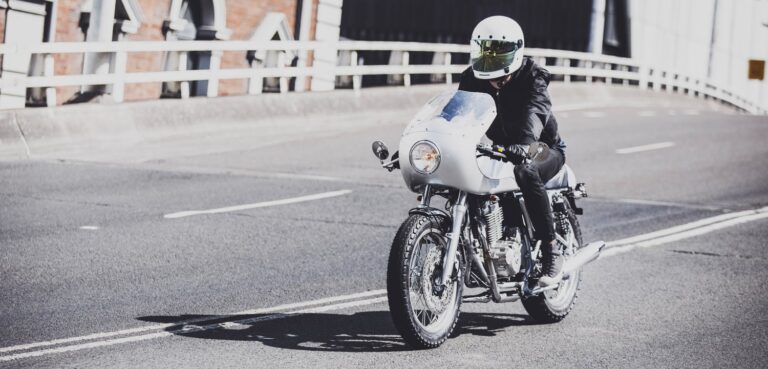The allure of the open road, wind whistling past you as you ride around hills, is what many of us associate with motorcycling and what attracts us to get on two wheels in the first place. But riding isn’t without risks and while we all want the full experience, there are steps you can take to ensure your rides are as safe as they are exciting.
Motorcycle riding is thrilling – the freedom to hit the road whenever you want, go wherever you want, and ride exactly as you want. However, with such freedom comes a responsibility to ensure you’re keeping yourself and others on the road safe.
For new riders in particular, it’s essential to be aware of the risks and what you can do to steer (pun intended) clear of any hairy situations. While you can control what you do on the roads, you can’t control what others do, so it’s best to undertake a ‘no surprises’ approach to motorcycle riding so you can feel in control whenever you head out for a ride.
So what does “no surprises” mean? There’s a misconception that any accidents on the road happen because of a lack of skill from the rider. While this is definitely a factor in some accidents, there are also other riders, drivers, pedestrians, and anyone else on the road to think about.
Here are some tips to help you have a “no surprises” ride, stay safe, and enjoy all the fun of riding while minimising the risks.
Ride Defensively
Defensive riding is the cornerstone of motorcycle safety. It’s the art of not just thinking about yourself when you’re on the road, it’s about being proactive and vigilant and doing what you can to prevent crashes before they occur.
For new riders, this is especially important. The longer you spend on the road, the easier it is to spot when something is awry. But for new riders, that sixth sense isn’t yet developed. Some of the easiest ways to ride defensively are to assume other road users may not see you and therefore may do unexpected things. If you always work to the theory that the people around you can’t see you, it will change how you act. Leave more space between you and other vehicles in case they do something unexpected, stay aware of any potential hazards on the road, and take note of your surroundings so you have an escape plan if something does happen.
It also means making sure you’re doing everything right. If you’re riding at the right speed, in the correct position on the road, if a car does change lanes without warning, cut you off, or slams on the brakes, you’re better placed to be able to act quickly and keep yourself safe.
Riding defensively isn’t about being scared of your surroundings or nervous when you’re on the road. While it may feel strange when you’re new to riding, eventually this will become second nature, but in the meantime keeping your wits about you may save your life.
Group Riding Rules
What better way to enjoy your ride than with some mates? Half of the enjoyment of riding is the community it gives you, the sense of camaraderie and the new friends you make along the way. Riding in a group is fun, but there are some simple rules you should familiarise yourself with before you hop on the bike.
Groups may want to ride in a staggered formation. This gives you a clear view ahead of you and plenty of space so you can stick to that defensive riding we spoke about earlier. It also lets you move around if you need to escape potholes, rocks, or anything else the road may throw at you. This usually means the first person starting on one side of the lane, the one behind them on the other, and then the third back to the same alignment as the first. You also want to allow a decent gap between you and the rider in front, depending on the speed you’re travelling. The most experienced rider should go in the front, with the less experienced travelling in the middle, giving them plenty of time to respond to any hazards, but also making sure there’s someone watching over them.
Communication is key when you’re travelling with others. Familiarise yourself with hand signals – this is another reason to keep the most experienced rider at the front and make sure you’ve discussed them before you start if you’re unsure. Riders will signal for things including turns, hazards, stops, and any changes in route and speed.
Keep all these things in mind, but also, just be sensible. Don’t blindly follow the leader if they’re passing a vehicle, keep an eye on your mirrors, and if something feels wrong, use your own common sense.
Group riding is fun. It’s a great way to spend time with your mates and it takes some of the uncertainty out of riding for newbies, as long as you know the rules and stay aware while you’re doing it, you’ll have a great time.
Stay Aware of Changing Conditions
Weather and road conditions can drastically change the safety of your ride. The easiest way to stay across this is to check the weather forecast before you ride. Are there any storms on the horizon? Has it been raining where you’re riding to? Unless you’re staying local, check the roads in the area you’re visiting. Unplanned roadworks or changing conditions can substantially change your ride, so you want to ensure you’ve planned for them before heading off.
Rain and wind will obviously have a big impact on how you ride, but wet roads from recent rain might be harder to predict. If you’re unsure, or you feel unsafe, be more cautious about how you ride. If you spot a hazard and you’re worried, plan another route.
In general, if you’re unsure about your journey, go a little slower, don’t take any risks. You can plan as well as you want to, but things can change while you’re already on the road. As long as you remember the basics, you’re in the right gear, and you’re riding defensively, you minimise your risk during changing conditions.
Continuous Learning
Learning doesn’t stop when you get your licence! Like anything in life, you’ll always be evolving as a rider, learning more, getting more experienced, and becoming more confident.
You’ll learn while you’re on the road, you’ll learn while you’re riding with mates, but you can also enroll in courses to expand your knowledge. You can seek out groups with experienced riders, or join a club – there are plenty of ways to find out new tips and tricks for riding in the best, and safest way.
Getting more knowledge will mean you’ll become more confident. While we obviously want to steer away from getting cocky, more confident riders feel better in difficult situations, defensive riding becomes second nature and you’ll be able to explore new areas, travel further and ride in groups with ease. It’s a win-win; learn more, ride better, and have more fun.
Riding Within Your Means
One of the most common mistakes new riders make is attempting maneuvers beyond their skill level or using a bike that is too powerful for their capabilities. Riding within your means is about understanding your own personal limitations, but also the limits of your bike.
Hopping on the most powerful or biggest bike money can buy isn’t always going to give you the best experience. Starting out on a bike that matches your skill will make it easier to improve your skills while you’re starting out.
As you get more confident you can move onto a more advanced bike, but starting out trying to do more than you’re comfortable with is more likely to scare you off riding, or worse, cause an accident. Don’t get too far ahead of yourself, stick to easier routes, a simpler bike, and conditions you know you can ride in until you build up the skills to tackle something more intense.
Riding a motorcycle isn’t just a fun hobby, it’s a great way to travel, and it gives you freedom and excitement at your fingertips (or, at least, in your garage). By mastering the essentials, riding defensively, and making sure you ride within your means, you’re reducing your chance of accidents and giving yourself the best chance of having a great time on your bike without any nasty surprises.

































